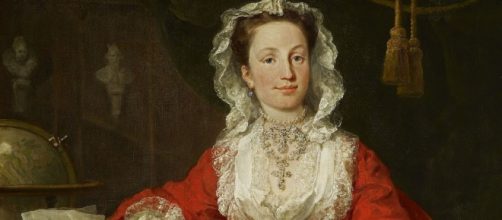When it comes to the affinity between painter and patron, the connection between William Hogarth and the aristocrat Mary Edwards is mighty observable. They were both known as freethinkers, and his portrait of her, coming to Tate Britain in November, tells the story. Each had the same low opinion of marriage practices of their time – the 18th-century.
Airing high society’s dirty laundry
Hogarth made it his business to expose the emptiness in marriages of convenience for money or social status, which was the habit in aristocratic circles. And in her way, Mary Edwards exposed that emptiness, too.
(More about her in a moment).
Marriage a la Mode, Hogarth’s satirical six-picture series, mocks the arranged marriages in the high society of his time. He did it so much that Ian Chilvers, publisher of the Oxford University Press, dubbed him “A preacher in paint.” In one of the paintings in this series, Hogarth shows a disinterested-looking groom lolling on a hallway chair in an ornate Rococo-style home, paying no attention to his bride sitting nearby. She plays cards by herself with an equally indifferent look.
When the husband marries for money
Mary had a husband like a groom in Marriage a la Mode. But as she was independently wealthy, she was able to opt out of her marriage. The Observer suggests that her name doesn’t ring a bell with most art lovers because she doesn’t fit the history of her time.
She rebelled against custom and abandoned her marriage. Hogarth caught her free spirit in his 1742 painting of her wearing a red dress dripping with diamonds.
But Mary wasn’t like the bride in Marriage a la Mode. Her legal way out at the time was to refuse to acknowledge Hamilton as her spouse and declaring herself a spinster. In that way, she was able to hold onto her fortune. You can see her grit in Hogarth’s painting.
She looks at you, self-assured, without affectation – a straight-shooter, you might say, which was typical of portraits of men, not of women. According to Alice Insley, assistant curator at Tate Britain, the red dress and her direct gaze add up to “a very dynamic portrait.” But as if to make sure you get the portrait's message, Hogarth also threw in a large hunting dog instead of a lady's usual lapdog.
Piling on
Wait, there’s more. Behind Mary, Hogarth included portraits of Elizabeth I and Alfred the Great. According to Insley, they were strongly linked with the idea of English liberty. But there’s yet another add-on that testifies t Mary’s independent spirit. Pages lying by her side are from Joseph Addison's play Cato, which was all about resistance to the autocracy of Caesarism.
Hogarth got a lot into the portrait of Mary Edwards, some might say, on the side of overkill. Shades of the “preacher in paint” that Chilvers alluded to. The painter and his patron were also close friends. Comrades in arms against the mores of their time. She also commissioned a lot of his work. Don’t you wish that contemporary artists like Jeff Koons and the galleries who represent him would quit pushing vacuousness and kitschiness? It’s annoying.


